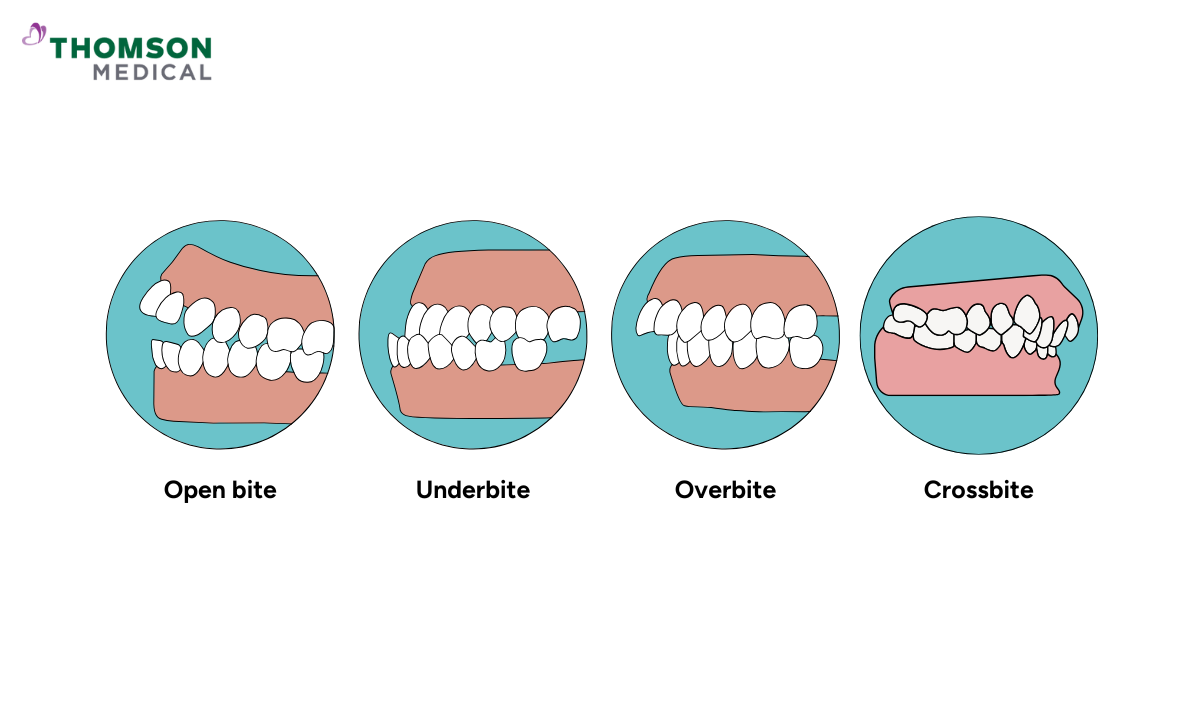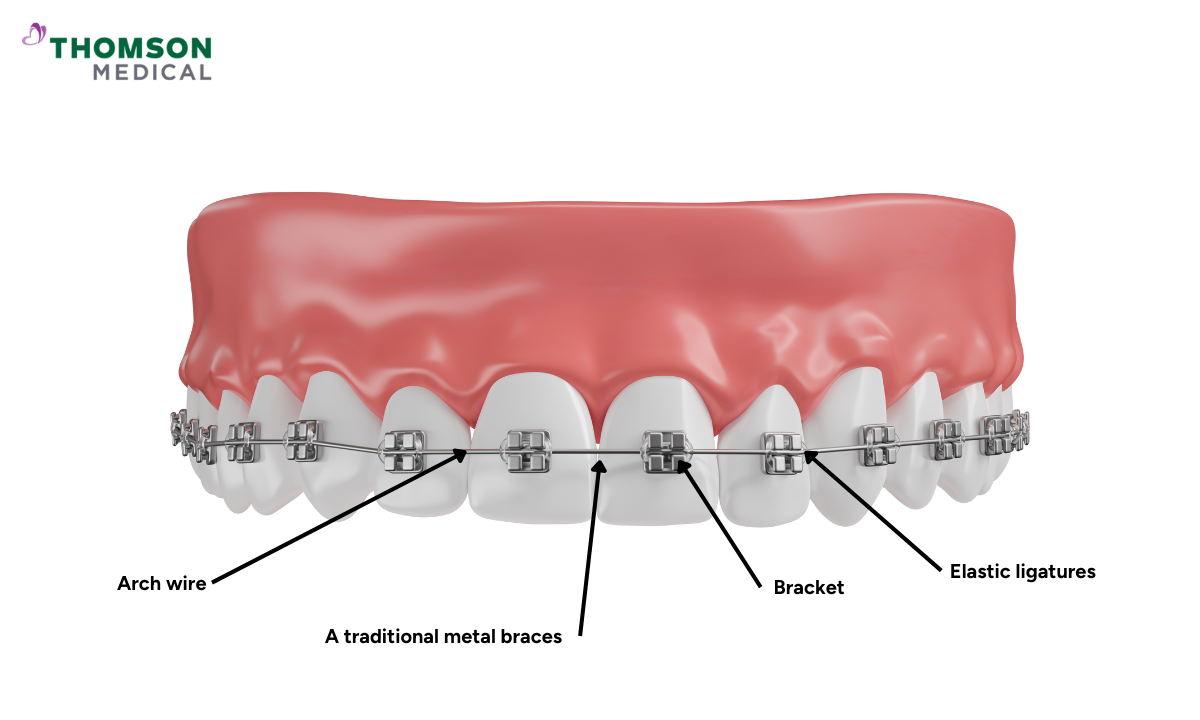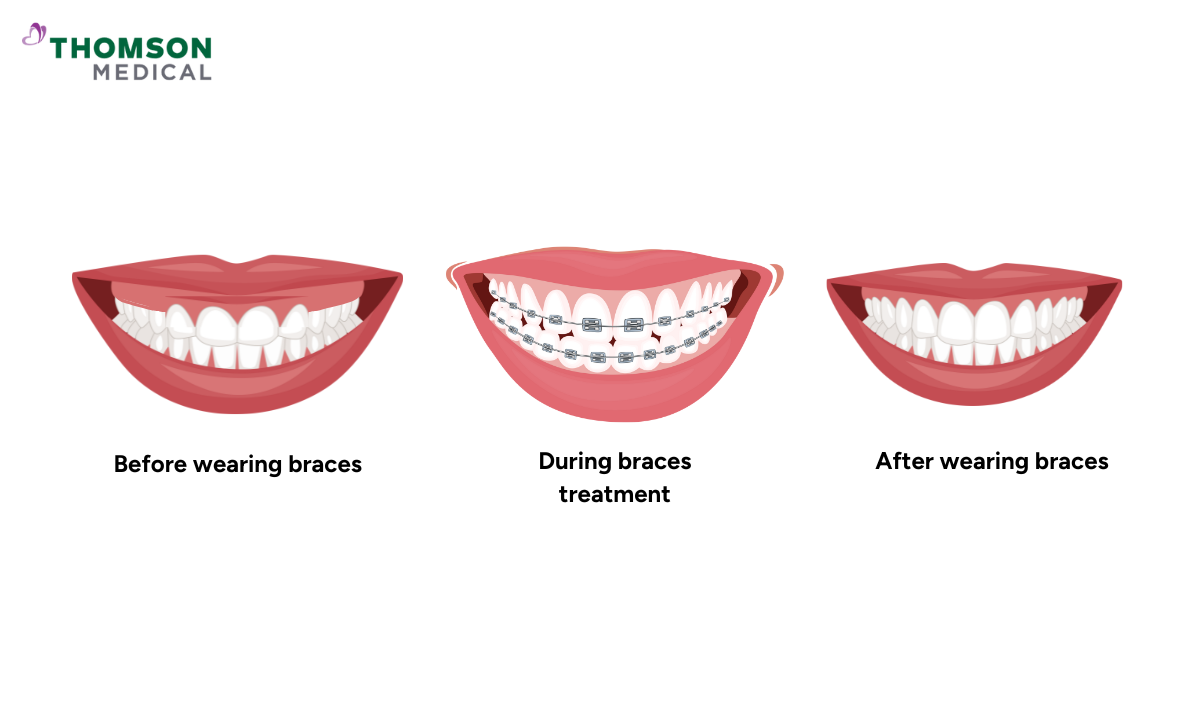What are braces for teeth?
Braces are dental appliances used in orthodontic treatment. While their main purpose is to straighten crooked or crowded teeth, braces can also correct other bite problems. This not only helps you chew more efficiently but also reduces the risk of jaw pain and temporomandibular joint (TMJ) disorders.
Without braces, these problems can make it difficult to maintain good oral hygiene, increase your risk of gum disease, and could affect your beautiful smile.
Who can wear braces?
Braces are suitable for individuals of all ages but are usually installed only after the first set of teeth (baby teeth) has been replaced by permanent teeth.
For children, orthodontists generally recommend starting braces treatment between the ages of 9 and 14. This period, when most or all permanent teeth have erupted and the jaw is still growing, makes it easier to guide teeth into proper alignment. Adults usually require more time because their dental bones have fully matured.
Should I get braces?
Here are some dental issues that you might consider getting braces for, such as:
1) Crooked teeth
This condition, also known as misaligned teeth, results in the teeth being improperly positioned and overlapping over one another.
2) Spacing
This orthodontic issue occurs when there's extra space between two or more teeth.
3) Overcrowding
This issue occurs when the upper front teeth protrude forward over the lower front teeth.
4) Overjet (buck teeth)
This orthodontic issue occurs when the upper front teeth stick out horizontally over the lower front teeth. An overjet is different from an overbite, where the upper teeth cover the lower teeth vertically.
5) Overbite
An overbite is a condition where your upper front teeth overlap with your lower teeth more than they should (further than 2 mm).
6) Underbite
An underbite occurs when the lower teeth and jaw protrude in front of the upper teeth.

7) Crossbite
A crossbite occurs when both the upper and lower teeth don't line up properly when the mouth is closed.
8) Open bite
An open bite is a condition where there's a gap between the upper and lower teeth when the mouth is closed.
If you’re experiencing any of these issues, consulting an orthodontist can help to determine if braces are the right solution for you. Request an appointment with Thomson Dental Centre for personalised recommendations based on your dental conditions.
How do braces work?
To help correct your dental issues, braces work by gradually applying pressure to your teeth over time, guiding them into a more ideal position. These orthodontic appliances consist of several components that work together to achieve this goal.
Brackets
These small metal or ceramic pieces are bonded to the surface of each tooth using a dental adhesive. Brackets act as anchor points for the arch wire, which will pull your teeth to the correct position.
Arch wire
This is a thin wire that connects the brackets and helps guide your teeth into their optimal positions. The orthodontist will adjust this wire during your routine visits to ensure your teeth receive the appropriate pressure.
Arch wires come in various types, including nickel-titanium (NiTi), copper NiTi, beta titanium (TMA), and stainless steel. Each material has distinct characteristics in terms of flexibility, strength, and friction, all of which play a role in guiding tooth movement throughout orthodontic treatment.
Elastic ligatures
A tiny O-shaped rubber band, known as an elastic ligature, fits around the brackets to hold the arch wire in place. These rubber bands also come in various colours, allowing you to personalise your braces.
Braces rubber bands
For bite alignment issues, a rubber bands may be placed around the back teeth. These bands help apply pressure to the jaw to help align the upper and lower teeth.
Coil spring
Sometimes, dentists place a coil spring between brackets, creating space between teeth, and move them into the proper position.

Different types of braces
There are several available types of braces that you can choose from. But determining which one is best for you will depend on several factors, including your specific dental problem, the severity of your condition, and your personal preferences.
1) Conventional metal braces
Also known as traditional braces, these dental appliances are usually what most people imagine when they think of braces. It uses a flexible arch wire, metal brackets, and braces bands to gently shift your teeth over time.
Metal braces are strong and effective for all types of dental misalignments while also being relatively affordable. It's visible when you smile, so if you worry about your appearance, it might not be the best option.
But if you’re feeling creative, you can choose brightly coloured elastic ligatures to customise your braces and show your personality.
2) Ceramic braces
These ceramic braces function similarly to conventional metal braces, but the key differences are that the brackets, arch wires, and elastic ligatures are tooth-coloured, making them less noticeable.
So if you're concerned about how you look when smiling, these braces might be an option. But ceramic braces are usually more expensive, prone to staining, and more fragile compared to traditional metal braces.
3) Self-ligating braces
Self-ligating braces look similar to traditional braces but use a clip to secure the arch wire within the metal brackets instead of using elastic ligatures. This type of braces usually needs fewer visits to the orthodontist and may shorten treatment time.
However, self-ligating braces might not be suitable for all types of misalignments and tend to be pricier than both metal and ceramic options.
4) Lingual braces
Unlike traditional metal or ceramic braces, these braces are invisible when you smile due to their placement behind your teeth. However, lingual braces can be uncomfortable, harder to clean, and generally more expensive than conventional metal braces.
Nonetheless, hidden braces are the perfect option if you don't want people to know that you're wearing one.
Getting your braces
To get your braces, you need to visit the orthodontist for a consultation. During this appointment, the orthodontist will examine your teeth, mouth, and jaw. They may also ask you whether you have problems speaking, chewing, or swallowing.
Afterwards, your dentist may take a dental X-ray or 3D scan of your mouth to assess dental health and the alignment of your teeth. They may also make an impression of your teeth to create a replica, which will help determine the appropriate treatment steps.
The type of braces you will wear and treatment time will depend on the findings from your consultation, the severity of your misalignment, and whether your dental bones are still growing or have fully matured.
Preparation step
A dental procedure, such as extracting decaying teeth or treating a cavity, may be necessary before the installation of braces. If your teeth are closely spaced, spacers will be used at least a week prior to your braces installation.
Cleaning and installing the brackets
On the day of the procedure, your dentist will start by cleaning your teeth to remove plaque and tartar, which ensures a clean surface for the bracket to attach properly.
After that, a special adhesive material is applied to the surface of the teeth, which is then cured with a blue light, and then the bracket is placed.
Installing the arch wire
After all brackets are in place, an arch wire is threaded through them and attached to the molar teeth at the very back of your mouth.
After that, the arch wire is secured using elastic ligatures, but for self-ligating braces, these ligatures are not necessary.
Final adjustments
Once everything is in place, your orthodontist will trim excess wire to prevent discomfort and ensure everything is secure. They may also provide instructions on care and maintenance of your shiny new braces.
Braces specialist
Loading...
How long do braces take?
Depending on your dental condition, the treatment duration can vary from as little as 1 year to as long as 3 years. However, self-ligating braces may help shorten the treatment time.
During this treatment period, you’ll also need to routinely visit your orthodontist, roughly every month or so, to monitor progress and have your braces adjusted. Your first appointment usually happens around 4-8 weeks after you get your new races and focuses on correcting alignment issues before moving on to bite adjustment.
What to expect after completing braces
After you finish wearing braces, the treatment is not yet complete. To keep your teeth in the correct position, you will need to wear a retainer. There are two types of retainers you can choose from, including:
Permanent retainers
Permanent retainers, or fixed retainers, are thin metal wires that are bonded to the back of your teeth using an adhesive. These non-removable retainers are commonly used on the front lower or upper teeth to avoid shifting over time.
Since they only protect your front teeth, permanent retainers are recommended to be used in conjunction with removable retainers like Hawley and clear retainers.
Hawley retainers
These removable retainers are made from a durable acrylic piece that sits on the roof of your mouth. This piece is then attached with a metal wire that wraps around the outside of the teeth.
These retainers are custom-shaped to fit your mouth and are available in various colours. But since they don’t cover the teeth, this retainer doesn't protect against teeth grinding and isn’t as discreet as clear plastic retainers.
Clear retainers (essix retainers)
Made entirely of clear plastic, this type of retainer is more discreet than a Hawley retainer. It’s also cheaper and helps protect your teeth from grinding.
However, clear retainers are not as durable as the Hawley type and are easily lost due to their transparency.
For the first 3 to 9 months, it is recommended for you to wear your retainers full-time, except at mealtimes and during cleanings. Once these first few months pass, your teeth will have stabilised, allowing you to only wear the retainer at night.
Most orthodontists also recommend indefinite nightly wear of retainers after your braces treatment.
If you would like to get braces or use a retainer but are unsure which one is right for you, request an appointment with Thomson Dental Centre. Our dentists will help you explore what options are available and give tailored advice based on your needs.
Benefits and downsides of wearing braces
If you decide to wear braces, here are some of the benefits that you can get, such as:
Benefits of wearing braces
Better mouth function
Braces can correct bite issues like overbites, underbites, and crossbites, making it easier for you to chew or speak.
Improved oral health
Straight teeth are easier to clean, reducing the risk of cavities and gum disease. Also, correcting bite issues can help reduce wear on teeth and minimise jaw strain.
A more attractive appearance
Wearing braces can help to straighten your teeth and boost your self-esteem while smiling.

Downsides of wearing braces
While braces offer advantages for improving your teeth, there are some disadvantages that can be encountered, such as
Discomfort and soreness
You may feel soreness or discomfort after your braces are first fitted or after an adjustment. Over-the-counter painkillers can manage this pain, which typically lasts for a few days.
You may also request dental wax from your dentist to help cushion your mouth against any sharp areas.
Some types of braces, such as lingual braces, will be more uncomfortable. This is due to the placement of these braces behind the teeth, in the direction of the tongue.
Mouth irritation
The brackets and arch wires used in braces can irritate the inside of your lips and cheeks, especially in the early stages. You may use orthodontic wax to help reduce irritation.
Pro tip: After each adjustment, use your tongue to check for any protruding parts of the arch wire and ask your dentist to trim them if needed.
Food restrictions
You'll need to avoid certain foods that can damage your braces or get stuck in them, such as sticky candies, popcorn, nuts, and other hard or crunchy foods.
For hard foods like apples, cut them into smaller pieces to prevent brackets from breaking.
Costs of braces in Singapore
The cost of braces installation can vary depending on the type of brace, severity of your condition, and the extent of treatment required. In general, here are the costs of braces in Singapore:
Traditional metal braces usually cost between SGD 3,500 and SGD 5,000.
Ceramic braces could cost between SGD 4,500 and SGD 6,500.
The cost of self-ligating braces could range from $5,500 upwards to SGD 7,000.
The most expensive braces are lingual braces, which start from SGD 7,000 all the way to SGD 15,000 or even more.
In addition to the cost of the braces themselves, the initial consultation may also incur a fee of SGD 240 (including GST).
Unfortunately, non-surgical, cosmetic, or aesthetic dental treatments like braces (orthodontic treatments) are not eligible for Medisave or government subsidies. However, some insurance plans may come with dental coverage, including braces.
Additionally, select clinics do offer a discount for students and full-time National Servicemen (NSF) for an orthodontic procedure. For detailed fee information and payment options, please consult with your dental care provider and your insurers directly.
Enquire here for a detailed breakdown and personalised braces costs.
Achieving the best results with braces
Though braces are an excellent method to correct your teeth to their ideal position and boost your self-esteem, this treatment requires commitment for the best results. To ensure success, you must practice discipline and maintain excellent oral hygiene.
Here are some things you can do to take care of your teeth and braces for the best results:
Oral hygiene
Maintaining good oral hygiene with braces can be challenging, but it's important to prevent plaque buildup, cavities, or gum disease around the brackets and arch wires.
To maintain your dental hygiene, you can brush after every meal and utilise special tools like orthodontic flossers or interdental brushes to help clean between the braces.
Regular visits to the orthodontist
Visit your orthodontist regularly, at least once every 4-6 weeks, to monitor your progress. During these visits, your orthodontist will also tighten the arch wire or make other adjustments to ensure your teeth shift into the correct positions.
Eat softer foods
To avoid damaging your brackets or arch wires, you need to be mindful of what you eat and how you chew. Avoid eating hard, sugary, and sticky foods such as caramel, nuts, or hard candies.
Instead, eat soft foods like yoghurt and steamed vegetables, or soft fruits. Cutting foods into smaller pieces can also make them easier to eat without causing damage to your braces.
FAQ
What age is best for braces?
There is no “best age” for braces because children, teens, and adults could benefit from this orthodontic treatment. But children and teens at the ages of 9 and 14 usually have more favourable outcomes, as their jawbone is still quite responsive to repositioning.
How much do braces cost in SG?
Braces in Singapore vary in price depending on the severity of your dental misalignment and the type of braces you choose. But in general, here’s how much braces cost:
Traditional metal braces: SGD 3,500-5,000
Ceramic braces: SGD 4,500-6,500
Self-ligating braces: SGD 5,500-7,000
Lingual braces: SGD 7,000-15,000
How long do teeth braces last?
An orthodontic treatment with traditional braces will usually last between 1 to 3 years, but self-ligating braces may reduce it to 2 years. After your time with braces is over, you'll need to wear retainers to maintain your teeth in the correct positions.
Is it painful to get braces?
You may experience temporary soreness or discomfort after the initial fitting and routine adjustments. Over-the-counter pain relief can manage this discomfort, which typically lasts a few days.
What are the side effects of braces?
Some mild effects from wearing braces includes:
Temporary discomfort and soreness
Mouth irritation from brackets and wires
Jaw pain
Difficulty eating
The information provided is intended for general guidance only and should not be considered medical advice. For personalised recommendations and tailored advice, you can consult a dentist at Thomson Dental Centre. Request an appointment with our specialists today.
For more information, contact us:
Thomson Dental Centre
Call: 6255 0770
WhatsApp: 8716 9594
Request an Appointment